
| myArmoury.com is now completely member-supported. Please contribute to our efforts with a donation. Your donations will go towards updating our site, modernizing it, and keeping it viable long-term.
Last 10 Donors: Anonymous, Daniel Sullivan, Chad Arnow, Jonathan Dean, M. Oroszlany, Sam Arwas, Barry C. Hutchins, Dan Kary, Oskar Gessler, Dave Tonge (View All Donors) |
| Author |
Message |
|
Niels Just Rasmussen
|
 Posted: Thu 14 Jan, 2016 1:10 pm Post subject: Kastenbrust images and possible chronology. Posted: Thu 14 Jan, 2016 1:10 pm Post subject: Kastenbrust images and possible chronology. |
 |
|
It is general consensus that the Kastenbrust was popular within a fairly limited time period between 1400-1450 with a likely peak between 1420-1440. Apparently only one actual armour survives and it is in Wien (Vienna).
Different kinds of styles can be discerned from pictures. Some with a "box-like" torso and others "domed" (and even breast like).
So I wonder if one can distinguish a Kastenbrust chronology based on precise dating of paintings?
Anyways I have located an extremely late depiction. A Kastenbrust on Skt. Jørgen (Saint George) from this church painting in the Roskilde Domkirke, Denmark. This, among other paintings in the cathedral, is dated 1465-1475.
He also appears to have a "langes messer" in the scabbard with S-curved quillons. Have a hunch it could be somewhat unusual for Saint George depictions, where one would expect a knightly sword?
This image of Skt. George (dated 1432-1435) by Rogier van der Weyden comes fairly close to the Danish depiction in the breast like shape of the torso.

Source: https://www.nga.gov/kids/rogier/rogier2.htm
Perhaps the Danish example has been inspired from continental paintings or perhaps this armour type was used in Denmark even after it was out of fashion most other places.
 Attachment: 135.73 KB Attachment: 135.73 KB
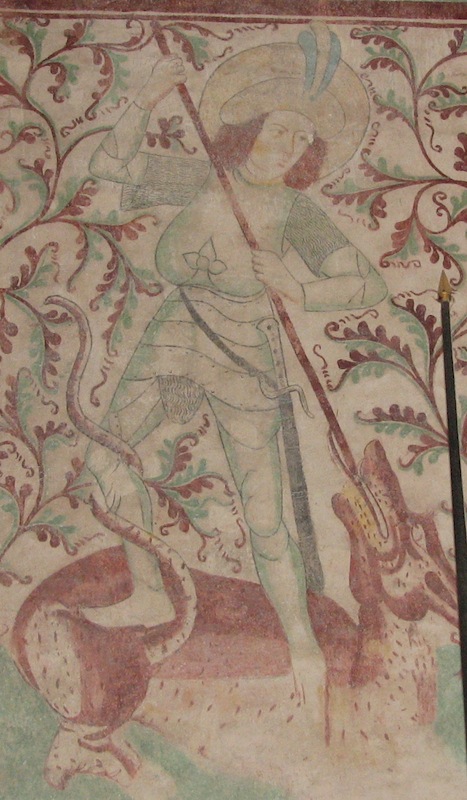
Skt. Jørgen (Saint George).
Roskilde Domkirke.
Dated: 1465-1475.
Source: http://natmus.dk/salg-og-ydelser/museumsfaglige-ydelser/kirker-og-kirkegaarde/kalkmalerier-i-danske-kirker/
|
|
  |
 |
|
Mark Lewis
|
 Posted: Thu 14 Jan, 2016 8:08 pm Post subject: Re: Kastenbrust images and possible chronology. Posted: Thu 14 Jan, 2016 8:08 pm Post subject: Re: Kastenbrust images and possible chronology. |
 |
|
| Niels Just Rasmussen wrote: | This image of Skt. George (dated 1432-1435) by Rogier van der Weyden comes fairly close to the Danish depiction in the breast like shape of the torso.
Perhaps the Danish example has been inspired from continental paintings or perhaps this armour type was used in Denmark even after it was out of fashion most other places. |
Interesting find! The fresco very clearly shows the "domed" type of kastenbrust at seemingly a very late date. It does seem very similar to van der Weyden's painting... did you notice how in both cases, St. George appears to be wearing a full mail shirt, with the sleeves worn loose above the plate armour? I think this is also an old-fashioned style by the time the fresco was painted. More comparisons will be needed to judge if this out-dated equipment was still in regular use in Denmark.
| Niels Just Rasmussen wrote: | | Different kinds of styles can be discerned from pictures. Some with a "box-like" torso and others "domed" (and even breast like). So I wonder if one can distinguish a Kastenbrust chronology based on precise dating of paintings? |
I think it is fair to say that in general the "boxy" style is earlier, and "domed" comes later. Boxy breastplates definitely appear by the 1420s, and seem to typically worn with a shirt or skirt of mail, sometimes only covering the front of the abdomen (examples forthcoming...). The more rounded breastplates seem to be frequently worn with the large fauld of plates - another later development. The rounded kastenbrust seems like it could be a natural transition between the early boxy-style armour, and late-Gothic styles.
A lot of armour is on display in the Albrechtsaltar, dated c. 1437, including the same combination of rounded kastenbrust, plate fauld, and loose mail sleeves.
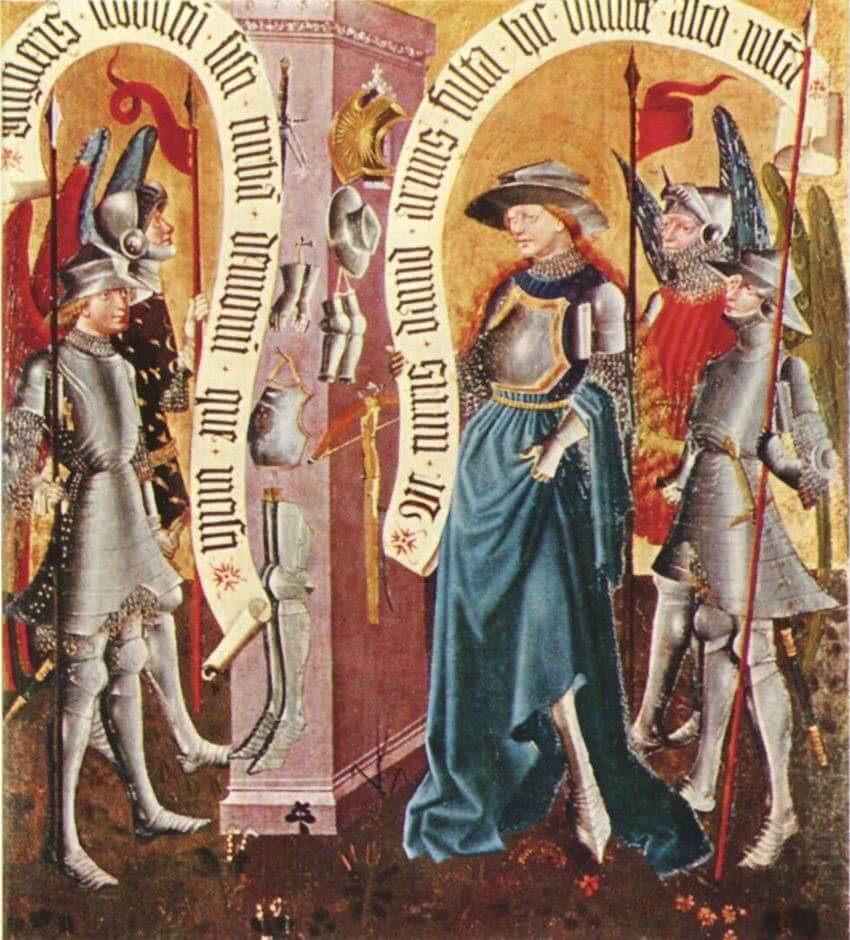
https://de.wikipedia.org/wiki/Meister_des_Albrechtsaltares_zu_Klosterneuburg
In the Wurzach Altarpiece by Hans Multscher, also dated c. 1437, both styles can be seen, rounded breastplate with fauld, boxy breastplate without. The depictions seem accurate for the time period, though Christ's tormentors in particular are often shown with distorted features, and strange, exotic or old-fashioned clothing and weapons, to symbolize their evil nature.

http://www.wga.hu/html_m/m/multsche/wurzach/
|
|
   |
 |
|
Niels Just Rasmussen
|
 Posted: Fri 15 Jan, 2016 8:03 am Post subject: Re: Kastenbrust images and possible chronology. Posted: Fri 15 Jan, 2016 8:03 am Post subject: Re: Kastenbrust images and possible chronology. |
 |
|
| Mark Lewis wrote: | | Niels Just Rasmussen wrote: | This image of Skt. George (dated 1432-1435) by Rogier van der Weyden comes fairly close to the Danish depiction in the breast like shape of the torso.
Perhaps the Danish example has been inspired from continental paintings or perhaps this armour type was used in Denmark even after it was out of fashion most other places. |
Interesting find! The fresco very clearly shows the "domed" type of kastenbrust at seemingly a very late date. It does seem very similar to van der Weyden's painting... did you notice how in both cases, St. George appears to be wearing a full mail shirt, with the sleeves worn loose above the plate armour? I think this is also an old-fashioned style by the time the fresco was painted. More comparisons will be needed to judge if this out-dated equipment was still in regular use in Denmark.
| Niels Just Rasmussen wrote: | | Different kinds of styles can be discerned from pictures. Some with a "box-like" torso and others "domed" (and even breast like). So I wonder if one can distinguish a Kastenbrust chronology based on precise dating of paintings? |
I think it is fair to say that in general the "boxy" style is earlier, and "domed" comes later. Boxy breastplates definitely appear by the 1420s, and seem to typically worn with a shirt or skirt of mail, sometimes only covering the front of the abdomen (examples forthcoming...). The more rounded breastplates seem to be frequently worn with the large fauld of plates - another later development. The rounded kastenbrust seems like it could be a natural transition between the early boxy-style armour, and late-Gothic styles.
A lot of armour is on display in the Albrechtsaltar, dated c. 1437, including the same combination of rounded kastenbrust, plate fauld, and loose mail sleeves.
In the Wurzach Altarpiece by Hans Multscher, also dated c. 1437, both styles can be seen, rounded breastplate with fauld, boxy breastplate without. The depictions seem accurate for the time period, though Christ's tormentors in particular are often shown with distorted features, and strange, exotic or old-fashioned clothing and weapons, to symbolize their evil nature.

http://www.wga.hu/html_m/m/multsche/wurzach/ |
Could the mail covering of the arms be due to early plate mails having fairly thin metal covering? We don't see any complex reinforced plate elbow joints.
So we can have "boxed" and "domed" as two major groups, but we can also discern some subgroups.
Among the domed type, we can have a Kastenbrust with a single dome or with dual breast-like dome structure.
In your last picture you also have a character raising his arms with a "striated" Kastenbrust (where you can't really call it "boxed" or "domed" -> do you perhaps call it "fluted" ?).
Even the number of striations can vary: This examples have three lines, but other armours shows five lines or perhaps even more? With the striation type armour they also appear to be more flat with increasing striation, so at a point it's almost not really a Kastenbrust anymore?
Roskilde Domkirke have more examples of both domed and fluted/striated Kastenbrust also dated from 1465-1475 making the church paintings from this period in the Roskilde cathedral a Kastenbrust galore.
See attachments.
 Attachment: 124.72 KB Attachment: 124.72 KB
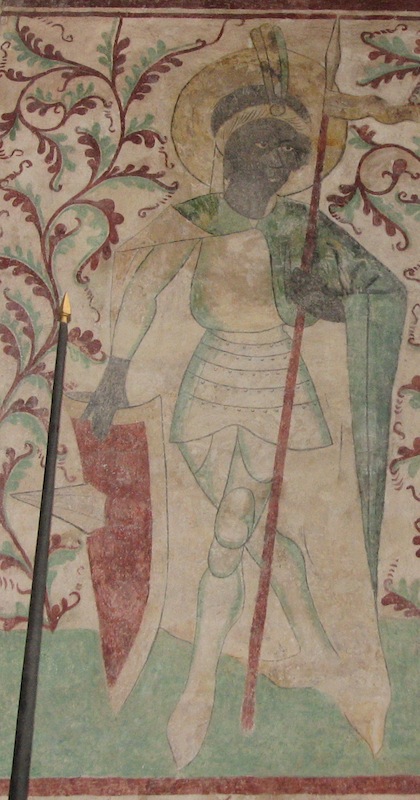
Black Knight with domed Kastenbrust.
Roskilde Domkirke.
Dated 1465-1475.
Source: http://natmus.dk/salg-og-ydelser/museumsfaglige-ydelser/kirker-og-kirkegaarde/kalkmalerier-i-danske-kirker/
 Attachment: 185.92 KB Attachment: 185.92 KB
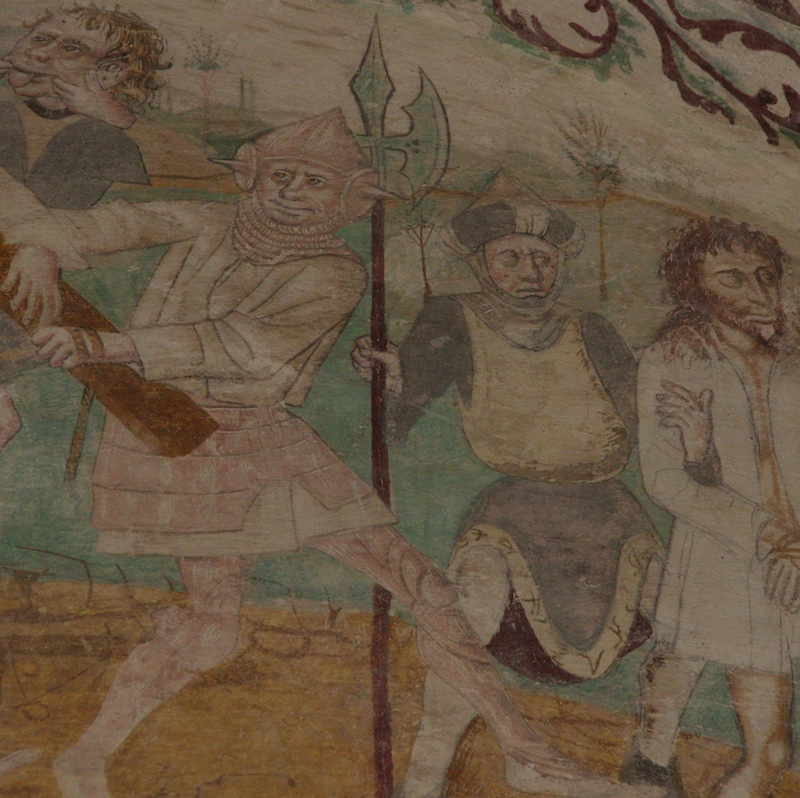
Soldier with domed Kastenbrust.
Roskilde Domkirke.
Dated 1465-1475.
Source: http://natmus.dk/salg-og-ydelser/museumsfaglige-ydelser/kirker-og-kirkegaarde/kalkmalerier-i-danske-kirker/
 Attachment: 126.69 KB Attachment: 126.69 KB
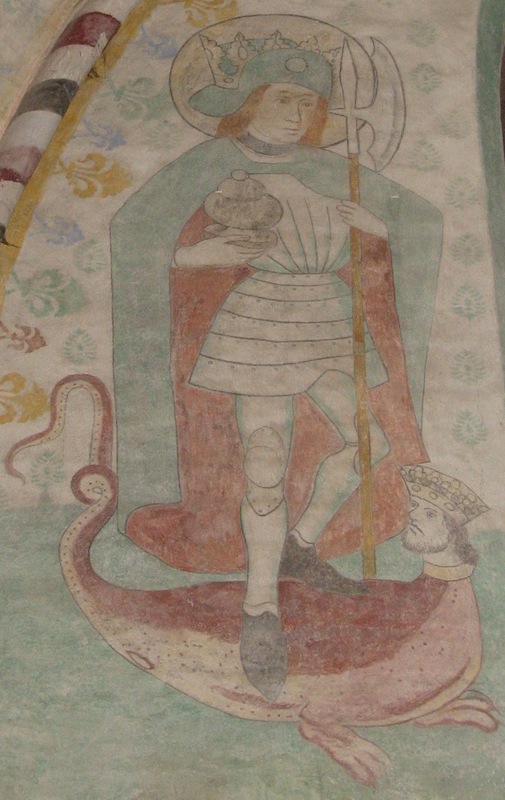
Norwegian Saint Olav with 6-striated Kastenbrust and bardiche.
Roskilde Domkirke.
Dated 1465-1475.
Source: http://natmus.dk/salg-og-ydelser/museumsfaglige-ydelser/kirker-og-kirkegaarde/kalkmalerier-i-danske-kirker/
 Attachment: 76.86 KB Attachment: 76.86 KB
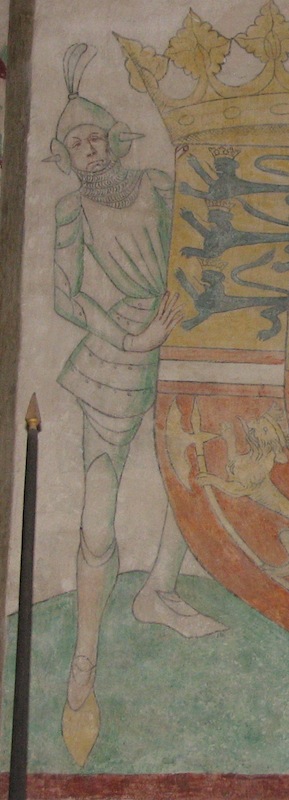
Danish King Christian I with 5-striated Kastenbrust standing next to the Danish Coat-of-Arms.
Roskilde Domkirke.
Dated 1465-1475.
Source: http://natmus.dk/salg-og-ydelser/museumsfaglige-ydelser/kirker-og-kirkegaarde/kalkmalerier-i-danske-kirker/
 Attachment: 56.85 KB Attachment: 56.85 KB

Soldier with 5-striated? Kastenbrust.
Roskilde Domkirke.
Dated 1465-1475.
Source: http://natmus.dk/salg-og-ydelser/museumsfaglige-ydelser/kirker-og-kirkegaarde/kalkmalerier-i-danske-kirker/
|
|
  |
 |
|
Mart Shearer
|
 Posted: Fri 15 Jan, 2016 9:01 am Post subject: Posted: Fri 15 Jan, 2016 9:01 am Post subject: |
 |
|
Mars, Astrologisch-astronomische Sammlung, Staatsbibliothek Berlin, Ms. germ. fol. 244, fo.91r, Middle Rhine, 1445.
http://manuscriptminiatures.com/5737/21173/

The bascinets and breastplates all seem to point to a dating before 1450. Either the artist was copying older art, or the dating for the cathedral paintings needs to be seriously revised. It could be that the drawings were prepared for the restoration after the 1443 fire, but were not executed for decades. Another possibility as that the fire damaged the original paintings, but left enough trace of them where they were restored to their original appearance at a later date.
ferrum ferro acuitur et homo exacuit faciem amici sui
Last edited by Mart Shearer on Fri 15 Jan, 2016 9:23 am; edited 1 time in total
|
|
  |
 |
|
Niels Just Rasmussen
|
 Posted: Fri 15 Jan, 2016 9:19 am Post subject: Posted: Fri 15 Jan, 2016 9:19 am Post subject: |
 |
|
Nice Mart. A 1-striated domed Kastenbrust.
So it seems possible that with time you get increased number of striations/flutes in the armour - anyone have an idea of its function?
1445 seems also fairly late for being middle Rhine, that was often the center for new development!
|
|
  |
 |
|
Mark Lewis
|
 Posted: Sat 16 Jan, 2016 4:53 am Post subject: Re: Kastenbrust images and possible chronology. Posted: Sat 16 Jan, 2016 4:53 am Post subject: Re: Kastenbrust images and possible chronology. |
 |
|
| Niels Just Rasmussen wrote: | Among the domed type, we can have a Kastenbrust with a single dome or with dual breast-like dome structure. In your last picture you also have a character raising his arms with a "striated" Kastenbrust (where you can't really call it "boxed" or "domed" -> do you perhaps call it "fluted" ?).
With the striation type armour they also appear to be more flat with increasing striation, so at a point it's almost not really a Kastenbrust anymore?
|
Styles evolve gradually... Whatever labels we use, I think we can see a progression from the hard-edged, boxy form of breastplate (also noticeable in gauntlets) to less angular and more rounded forms, with increasing fluted decoration, which ultimately are easily replaced or absorbed into the better known late-Gothic style of armour, produced in Germany and in Italy in the "German style", alla tedesca.
Here is the only known surviving example of a kastenbrust, in Vienna as Niels mentioned. A example of the later style with a more rounded profile, probably from the 1440s. Some (probably all?) of the other armour elements are not original to the breastplate.
 
A good example of the earlier boxy style can be found in Hamburg. It can be securely dated to 1424-26 from a known commission from English merchants for an altarpiece of Thomas Beckett's martyrdom. Beneath the breastplate, the soldiers wear a separate skirt of mail, I think "paunce" is a contemporary term for it.

Another great example comes from the panel of Jan van Eyck's Ghent Altarpiece known as the Knights of Christ, dated 1432. The knight on the left wears a boxy breastplate over a very similar green garment as appears in the Hamburg painting above. The second knight is more heavily armoured with a more rounded, fluted kastenbrust combined with a deep fauld of plates; his gauntlets are also of a boxy, hard-angled design.

The Ghent Altarpiece can now be viewed online in near-microscopic detail: http://closertovaneyck.kikirpa.be/#home
|
|
   |
 |
|
Niels Just Rasmussen
|
 Posted: Sat 16 Jan, 2016 6:35 am Post subject: Re: Kastenbrust images and possible chronology. Posted: Sat 16 Jan, 2016 6:35 am Post subject: Re: Kastenbrust images and possible chronology. |
 |
|
| Mark Lewis wrote: | | Niels Just Rasmussen wrote: | Among the domed type, we can have a Kastenbrust with a single dome or with dual breast-like dome structure. In your last picture you also have a character raising his arms with a "striated" Kastenbrust (where you can't really call it "boxed" or "domed" -> do you perhaps call it "fluted" ?).
With the striation type armour they also appear to be more flat with increasing striation, so at a point it's almost not really a Kastenbrust anymore?
|
Styles evolve gradually... Whatever labels we use, I think we can see a progression from the hard-edged, boxy form of breastplate (also noticeable in gauntlets) to less angular and more rounded forms, with increasing fluted decoration, which ultimately are easily replaced or absorbed into the better known late-Gothic style of armour, produced in Germany and in Italy in the "German style", alla tedesca.
A good example of the earlier boxy style can be found in Hamburg. It can be securely dated to 1424-26 from a known commission from English merchants for an altarpiece of Thomas Beckett's martyrdom. Beneath the breastplate, the soldiers wear a separate skirt of mail, I think "paunce" is a contemporary term for it.
Another great example comes from the panel of Jan van Eyck's Ghent Altarpiece known as the Knights of Christ, dated 1432. The knight on the left wears a boxy breastplate over a very similar green garment as appears in the Hamburg painting above. The second knight is more heavily armoured with a more rounded, fluted kastenbrust combined with a deep fauld of plates; his gauntlets are also of a boxy, hard-angled design.

The Ghent Altarpiece can now be viewed online in near-microscopic detail: http://closertovaneyck.kikirpa.be/#home |
So the boxy form of the 1420's (we seemingly have no image of them from a secure earlier date) developed fairly fast into a complex fluted form already with van Eyck's painting in 1432.
It's actually quite significant that the image shows both a boxy kastenbrust and an 8-fluted kastenbrust (thanks to the zoom) right next to each other.
Perhaps fluting is just an added option for the especially rich, but the kastenbrust armour generally have a progression from box-shape to dome-shape with time. An armour with 8 flutes shows that number of flutes didn't increase over time as the Danish late examples has 5 or 6 flutes. Making the flutes would add to increased work-load and skill level of the armourer, so that is why I think it's a cost-restriction for the buyer!
What seems to be very clear is that in Denmark the armour types are delayed compared to Germany as you find Danish box Kastenbrust as late as in the 1440's and domed (with or without fluting) in 1465-1475.
This delay could be perhaps that once expert armourers figured out that fashion was changing they perhaps relocated from Germany to the towns in Scandinavia to sell their expertise, thus bringing in a new fashion here while it was getting outdated further south?
It seems that in the Rhine area the first changes from boxed to domed kastenbrust happens in the early 1430's (van Eyck picture to van der Weyden's).
|
|
  |
 |
|
Mart Shearer
|
 Posted: Sat 16 Jan, 2016 7:34 am Post subject: Re: Kastenbrust images and possible chronology. Posted: Sat 16 Jan, 2016 7:34 am Post subject: Re: Kastenbrust images and possible chronology. |
 |
|
| Mark Lewis wrote: | | A good example of the earlier boxy style can be found in Hamburg. It can be securely dated to 1424-26 from a known commission from English merchants for an altarpiece of Thomas Beckett's martyrdom. Beneath the breastplate, the soldiers wear a separate skirt of mail, I think "paunce" is a contemporary term for it. |
In English, these mail skirts frequently appear as paunce, paunsse, etc.. Sometimes they show up in documents as pans. Thom Richardson recently mentioned he now believes they have some sort of integral groin protection. The Italians seem fond of attaching a fringe of mail to the bottom fauld, and wearing a paunce beneath that. German sources sometimes show an apron of mail, only covering the front. There's an English account mentioning those:
| Quote: | | John Whytewood. The coste off the harnessynge of a man. In primis, a jaeke with slevys, viiis. Item, a apurne and a gurgytte of mayle, iis. .... |
Then there are these odd breastplates shown in the contemporary War Book, ÖNB Cod. 3062, from 1437.
 Attachment: 94.49 KB Attachment: 94.49 KB
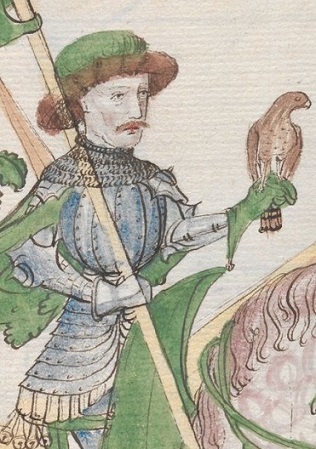
ÖNB Cod. 3062, fo.082r
 Attachment: 87.27 KB Attachment: 87.27 KB
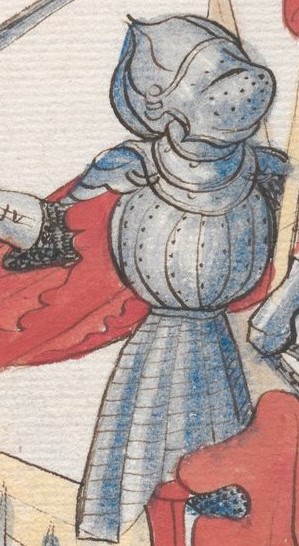
ÖNB Cod. 3062, fo.108r
ferrum ferro acuitur et homo exacuit faciem amici sui
|
|
  |
 |
|
Mart Shearer
|
 Posted: Sat 16 Jan, 2016 8:26 am Post subject: Posted: Sat 16 Jan, 2016 8:26 am Post subject: |
 |
|
One of the earliest box-breasts I have seen appears in a Speculum humanae salvationis, BNF Latin 512, from Basel showing II Samuel 23:16. Unfortunately the BNF gives the dating a wide berth of 1401-1500, but the appearance of a bascinet with bretache alongside the kastenbrust can't but it much beyond 1410.
http://gallica.bnf.fr/ark:/12148/btv1b60002575/f31.item
 Attachment: 52.41 KB Attachment: 52.41 KB
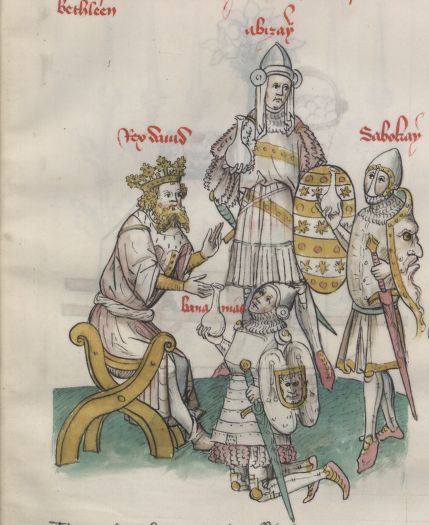
BNF Latin 512, fo.11r
ferrum ferro acuitur et homo exacuit faciem amici sui
|
|
  |
 |
|
Mark Lewis
|
 Posted: Sat 16 Jan, 2016 8:37 am Post subject: Re: Kastenbrust images and possible chronology. Posted: Sat 16 Jan, 2016 8:37 am Post subject: Re: Kastenbrust images and possible chronology. |
 |
|
| Mart Shearer wrote: | | In English, these mail skirts frequently appear as paunce, paunsse, etc.. Sometimes they show up in documents as pans. Thom Richardson recently mentioned he now believes they have some sort of integral groin protection. The Italians seem fond of attaching a fringe of mail to the bottom fauld, and wearing a paunce beneath that. German sources sometimes show an apron of mail, only covering the front. |
Thank you for clarifying. 
| Mart Shearer wrote: | | Then there are these odd breastplates shown in the contemporary War Book, ÖNB Cod. 3062, from 1437. |
I'm familiar with that manuscript, but don't know what to make of those breastplates... It does also have a good illustration of the German mail apron.

And here is probably a more conventional looking kastenbrust.

Most interesting to me has always been the the remarkable two-page illustration of the crusade against the Hussites.
 
Niels, there are a number of messers shown in this manuscript also, if you want to compare with your original fresco example... though none with large S-shaped guards that I have noticed yet.
|
|
   |
 |
|
Mark Lewis
|
 Posted: Sat 16 Jan, 2016 9:41 am Post subject: Re: Kastenbrust images and possible chronology. Posted: Sat 16 Jan, 2016 9:41 am Post subject: Re: Kastenbrust images and possible chronology. |
 |
|
| Mart Shearer wrote: | | Then there are these odd breastplates shown in the contemporary War Book, ÖNB Cod. 3062, from 1437. |
For comparison, Cod. 3068 contains many of the same illustrations (reproduced or derived from the earlier Bellifortis) but nearly all the figures wear "normal" breastplates. I think this version of the text is dated slightly earlier, to 1430-32.
Here is the corresponding illustration of Mars:

|
|
   |
 |
|
Mark Lewis
|
 Posted: Sat 16 Jan, 2016 10:29 am Post subject: Posted: Sat 16 Jan, 2016 10:29 am Post subject: |
 |
|
| Mart Shearer wrote: | | One of the earliest box-breasts I have seen appears in a Speculum humanae salvationis, BNF Latin 512, from Basel showing II Samuel 23:16. Unfortunately the BNF gives the dating a wide berth of 1401-1500, but the appearance of a bascinet with bretache alongside the kastenbrust can't but it much beyond 1410. |
That's a great example! I had a note for this one about the bretache but not the breastplates... What do you think of the possibility that anachronistic armour may be depicted however?
The art style seems to me to be quite sophisticated and throughout the manuscript effort has been taken to illustrate a variety of different types of clothing and armour. Some seems more "modern" like the large plate faulds and the clothing with "fluffy" trim often shown with kastenbrusts in the 1420s and 30s. Other figures are more old-fashioned, like Moab and Gideon here:


Various unusual or exotic details are included also, for example the warrior (Benaiah?) kneeling before David is holding a Moorish adarga shield, complete with tassels.

|
|
   |
 |
|
Mart Shearer
|
 Posted: Sat 16 Jan, 2016 10:49 am Post subject: Posted: Sat 16 Jan, 2016 10:49 am Post subject: |
 |
|
I would be comfortable with anything from 1410-1440 with that BNF manuscript. The bretache could be a copy of some old effigy or manuscript as a model, and there are some "exotic" features as you note. There are a large number of surviving copies of the Speculum humanae, and this doesn't seem to be directly modeled on another copy. I think it would be really pushing it to see a bretache into the 1420s, though.
ferrum ferro acuitur et homo exacuit faciem amici sui
|
|
  |
 |
|
Niels Just Rasmussen
|
 Posted: Sun 17 Jan, 2016 6:51 am Post subject: Posted: Sun 17 Jan, 2016 6:51 am Post subject: |
 |
|
Two church paintings from Skåne (Scania) - at the time when it was still Danish and not Swedish - shows that boxed Kastenbrust's were used up here even into the 1440's.
Thanks Mark for finding these examples 
Brønnestad Kirke/Brönnestad Kyrka. Herod's killing of the babies. Dating is set at ~1440 by scholars.

Source: http://armourinart.com/media/armourinart.com/original/393.jpg
Vester Sallerup Kirke/Västra Sallerups Kyrka.
Dating is unclear because the inscription "Klaos" could refer either to the knight or the kid.

Source: http://armourinart.com/media/armourinart.com/original/292.jpg
A) If the inscription refers to the kid then the church paintings has to be dated already around 1415, when Klaus Nielsen (Sparre af Ellinge) was 6 years and the knight in the boxed Kastenbrust is his dad Niels Svendsen (Sparre af Ellinge), who was knighted in 1411.
Such an early date for a Kastenbrust in Denmark sounds currently unlikely, but not entirely impossible.
B) If the inscription refers to the knight, then we have to date it around ~1445.
Klaus Nielsen (Sparre af Ellinge) is knighted in 1441 and then the kid in the painting is his son Niels Klausen (Sparre of Ellinge) - (he will be knighted in 1497).
I find interpretation B) to be the far most likely given our current evidence, though it goes against the common scholarly view, which probably have focused in the inscription being over the head of the kid. But if you have to name one person, why not the person who achieved something (like being knighted), instead of a kid who might not even make it to adulthood given the high child mortality in former times.
Furthermore a 1440's dating for boxed Kastenbrust's in Denmark does seem likely, if we hypothesize that Dwnmark is generally some decades late in fashion compared to the Rhine area.
Last edited by Niels Just Rasmussen on Sun 17 Jan, 2016 1:27 pm; edited 4 times in total
|
|
  |
 |
|
Niels Just Rasmussen
|
 Posted: Sun 17 Jan, 2016 7:05 am Post subject: Posted: Sun 17 Jan, 2016 7:05 am Post subject: |
 |
|
| Mart Shearer wrote: | One of the earliest box-breasts I have seen appears in a Speculum humanae salvationis, BNF Latin 512, from Basel showing II Samuel 23:16. Unfortunately the BNF gives the dating a wide berth of 1401-1500, but the appearance of a bascinet with bretache alongside the kastenbrust can't but it much beyond 1410.
http://gallica.bnf.fr/ark:/12148/btv1b60002575/f31.item |
| Mark Lewis wrote: |
That's a great example! I had a note for this one about the bretache but not the breastplates... What do you think of the possibility that anachronistic armour may be depicted however?
The art style seems to me to be quite sophisticated and throughout the manuscript effort has been taken to illustrate a variety of different types of clothing and armour. Some seems more "modern" like the large plate faulds and the clothing with "fluffy" trim often shown with kastenbrusts in the 1420s and 30s. Other figures are more old-fashioned, like Moab and Gideon here:
Various unusual or exotic details are included also, for example the warrior (Benaiah?) kneeling before David is holding a Moorish adarga shield, complete with tassels. |
| Mart Shearer wrote: | | I would be comfortable with anything from 1410-1440 with that BNF manuscript. The bretache could be a copy of some old effigy or manuscript as a model, and there are some "exotic" features as you note. There are a large number of surviving copies of the Speculum humanae, and this doesn't seem to be directly modeled on another copy. I think it would be really pushing it to see a bretache into the 1420s, though. |
So what is your opinions so far Mart and Mark for this manuscript.
Can we place already in ~1410 (making it the earliest depiction of a Kastenbrust) or does the other images more point to a definite 1420-1430's dating?
If a 1410 dating is possible, then a 1415 dating possibility from the Vester Sallurup Kirke Kastenbrust is no longer that unlikely.
Last edited by Niels Just Rasmussen on Sun 17 Jan, 2016 7:24 am; edited 1 time in total
|
|
  |
 |
|
Niels Just Rasmussen
|
 Posted: Sun 17 Jan, 2016 7:21 am Post subject: Re: Kastenbrust images and possible chronology. Posted: Sun 17 Jan, 2016 7:21 am Post subject: Re: Kastenbrust images and possible chronology. |
 |
|
| Mark Lewis wrote: | | Mart Shearer wrote: | | Then there are these odd breastplates shown in the contemporary War Book, ÖNB Cod. 3062, from 1437. |
For comparison, Cod. 3068 contains many of the same illustrations (reproduced or derived from the earlier Bellifortis) but nearly all the figures wear "normal" breastplates. I think this version of the text is dated slightly earlier, to 1430-32.
Here is the corresponding illustration of Mars:
 |
So these examples you have shown Mart and Mark are all from later copies of Konrad Kyeser's Bellifortis (1403-1405), where these later editions have updated armour??
So you have the Wien, Österreichische Nationalbibliothek (ÖNB), Cod. 3062 from 1437 with Iohannes Hartlieb: Liber de arte bellica (germanice).
then also Wien, Österreichische Nationalbibliothek (ÖNB), Cod. 3068 (1430-1432) with Iohannes Hartlieb: Liber de arte bellica (germanice) excerptus et in novum ordinem redactus.
So I assume that Johannes Hartlieb (1410-1468) made copies of Kyeser's Bellifortis or did he add anything himself?
Anyways a good example of a boxed Kastenburst still being around in the early 1430's as also seen in the Ghent alterpiece!
|
|
  |
 |
|
Mark Lewis
|
 Posted: Sun 17 Jan, 2016 9:24 am Post subject: Posted: Sun 17 Jan, 2016 9:24 am Post subject: |
 |
|
| Mart Shearer wrote: | | The bretache could be a copy of some old effigy or manuscript as a model, and there are some "exotic" features as you note. There are a large number of surviving copies of the Speculum humanae, and this doesn't seem to be directly modeled on another copy. |
The Speculum is a great resource for arms and armour, I have a number of copies saved on my computer... I did find another copy that also shows several adarga shields. Less surprising in this case, as the manuscript is reportedly from Catalonia, c. 1430-50.

http://bodley30.bodley.ox.ac.uk:8180/luna/ser...=Shelfmark
Here is another Speculum with very vivid artwork, dated 1427. Armour is shown in a very consistent style throughout, including several kastenbrusts.

http://www.e-codices.unifr.ch/en/list/one/bks/membr0008
| Niels Just Rasmussen wrote: | Two church paintings from Skåne (Scania) - at the time when it was still Danish and not Swedish - shows that boxed Kastenbrust's were used up here even into the 1440's.
Thanks Mark for finding these examples 
If the inscription refers to the knight, then we have to date it around ~1445. Klaus Nielsen (Sparre af Ellinge) is knighted in 1441 and then the kid in the painting is his son Niels Klausen (Sparre of Ellinge) - (he will be knighted in 1497). |
You're welcome  . I tend to agree with the 1440s dating, seems to be the conventionally reported dating for both frescos, and is consistent with Denmark being slightly old-fashioned (in art at least). . I tend to agree with the 1440s dating, seems to be the conventionally reported dating for both frescos, and is consistent with Denmark being slightly old-fashioned (in art at least).
Here is another late-dated example of a boxy kastenbrust, from a Dutch book of hours.

http://art.thewalters.org/detail/40216
| Niels Just Rasmussen wrote: | | So what is your opinions so far Mart and Mark for this manuscript. Can we place already in ~1410 (making it the earliest depiction of a Kastenbrust) or does the other images more point to a definite 1420-1430's dating? |
I would not be comfortable relying on this manuscript for dating purposes without additional information, due to the foreign/exotic/old-fashioned items being used for artistic effect.
| Niels Just Rasmussen wrote: | So these examples you have shown Mart and Mark are all from later copies of Konrad Kyeser's Bellifortis (1403-1405), where these later editions have updated armour??
So I assume that Johannes Hartlieb (1410-1468) made copies of Kyeser's Bellifortis or did he add anything himself? |
I don't know the full history, but the Bellifortis was copied in whole or in part in many other manuscripts right into the 16th century, sometimes combined with other material like Talhoffer's fight manuals and Vegetius' De Re Militari. A number of scenes are instantly recognizable, though the details of clothing and armour change with the time period.
|
|
   |
 |
|
Niels Just Rasmussen
|
 Posted: Sun 17 Jan, 2016 10:16 am Post subject: Posted: Sun 17 Jan, 2016 10:16 am Post subject: |
 |
|
| Mark Lewis wrote: |
Here is another Speculum with very vivid artwork, dated 1427. Armour is shown in a very consistent style throughout, including several kastenbrusts.

http://www.e-codices.unifr.ch/en/list/one/bks/membr0008
Here is another late-dated example of a boxy kastenbrust, from a Dutch book of hours.

http://art.thewalters.org/detail/40216
| Niels Just Rasmussen wrote: | So these examples you have shown Mart and Mark are all from later copies of Konrad Kyeser's Bellifortis (1403-1405), where these later editions have updated armour??
So I assume that Johannes Hartlieb (1410-1468) made copies of Kyeser's Bellifortis or did he add anything himself? |
I don't know the full history, but the Bellifortis was copied in whole or in part in many other manuscripts right into the 16th century, sometimes combined with other material like Talhoffer's fight manuals and Vegetius' De Re Militari. A number of scenes are instantly recognizable, though the details of clothing and armour change with the time period. |
So the Speculum from 1427 [Speculum Humanae Salvationis, Benediktinerkollegium Cod. membr. 8, Sarnen, Switzerland] is almong the earliest surely dated illustrations of the boxed Kastenbrust.
About the image from a Dutch "Book of Hours" [Walters Art Museum, Baltimore, accession number W.165]
Further info on the manuscript: http://thedigitalwalters.org/Data/WaltersManu...ption.html
It's reported as being mid-1400's and with illustration likely from the artist-group called the "Masters of the Delft Grisailles". It is later illustrated examples of the boxed Kastenbrust, though the dating of this manuscript is not very precise. The "Masters of the Delft Grisailles" was active in likely Delft at the convent of St. Agnes from around 1430's according to this website:
Source: http://www.lesenluminures.com/inventory/expo-...lles-20660
So the image is from 1430- to at whatever point the artist group was no longer active.
The Thott manuscript [MS Thott.290.2º] at the Copenhagen Royal Library contains both Talhoffer's Fechtbuch and Kyeser's Bellifortis - dated 1459.
[Thott is by the way a Scanian Noble-family and the manuscript was auction-acquired by Otto Thott (1703-1785), who was the last of the Danish Thott's and on his death his enormous book collection of 120.000 books went to the Copenhagen Royal Library].
Source: http://wiktenauer.com/wiki/Talhoffer_Fechtbuc...0.2%C2%BA)
|
|
  |
 |
|
Niels Just Rasmussen
|
 Posted: Sun 17 Jan, 2016 10:43 am Post subject: Re: Kastenbrust images and possible chronology. Posted: Sun 17 Jan, 2016 10:43 am Post subject: Re: Kastenbrust images and possible chronology. |
 |
|
| Mark Lewis wrote: |
Niels, there are a number of messers shown in this manuscript also, if you want to compare with your original fresco example... though none with large S-shaped guards that I have noticed yet. |
Found an S-guard messer in another Danish church - Såby Kirke in the town Kirke Såby, or written Saaby in the old spelling [confusing I know  ]. This place is quite near Roskilde (10 km west of it). ]. This place is quite near Roskilde (10 km west of it).
Here the church painting is dated 1490-1510, so having an S-guard messer seems to support a late dating for the S-guard messer appearing on the St. Jørgen-with-Kastenbrust painting from Roskilde Domkirke.
 Attachment: 127 KB Attachment: 127 KB
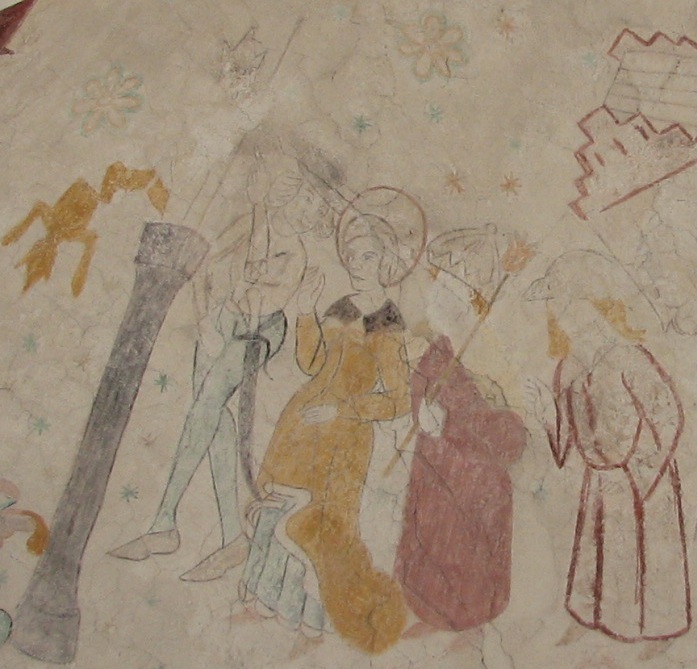
S-guard messer.
Skt. Katarina and the pagan idol.
Såby Kirke in Kirke Saaby.
Dated 1490-1510.
Source: http://natmus.dk/salg-og-ydelser/museumsfaglige-ydelser/kirker-og-kirkegaarde/kalkmalerier-i-danske-kirker/
Last edited by Niels Just Rasmussen on Mon 18 Jan, 2016 8:56 am; edited 3 times in total
|
|
  |
 |
|
Niels Just Rasmussen
|
 Posted: Sun 17 Jan, 2016 11:56 am Post subject: Posted: Sun 17 Jan, 2016 11:56 am Post subject: |
 |
|
Found two examples of a boxed Kastenbrust and a possible breast-like domed Kastenbrust from Gierslev Kirke in the western part of Sjælland.
The church paintings are currently dated 1520-1530 by Nationalmuseet, which seems very late.
Found an older paper (Danmarks kirker, page 1130) of the church, where the dating is 1475-1525.
Source: http://danmarkskirker.natmus.dk/uploads/tx_tc...5-1149.pdf
Nonetheless they are very late depictions - whether 1475 or 1525 - of the older boxed type Kastenbrust.
Sadly the paintings are mostly destroyed in this church as they weren't covered and thus would have been mostly protected to modern times.
 Attachment: 217.96 KB Attachment: 217.96 KB
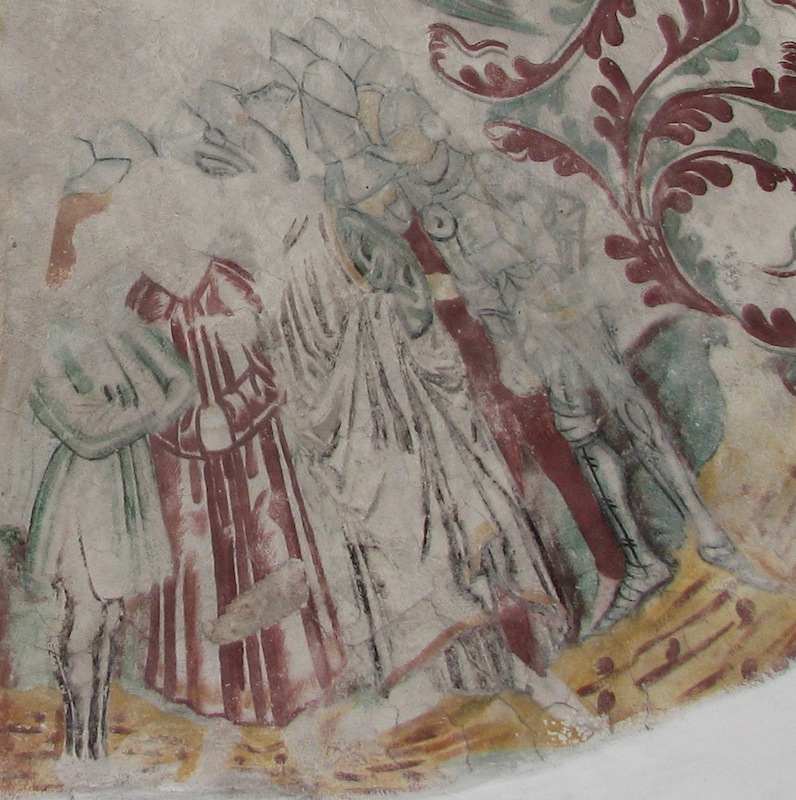
Soldier on the right in a boxed Kastenbrust.
Gierslev Kirke.
Dated 1520-1530.
Source: http://natmus.dk/salg-og-ydelser/museumsfaglige-ydelser/kirker-og-kirkegaarde/kalkmalerier-i-danske-kirker/
 Attachment: 94.77 KB Attachment: 94.77 KB
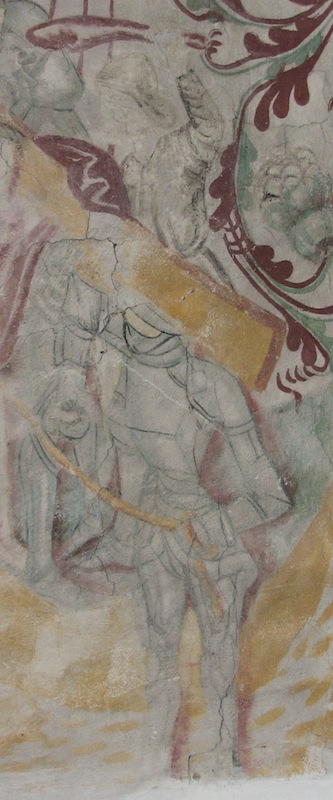
Soldier above with breast-like Kastenbrust and soldier below with boxed Kastenbrust.
Gierslev Kirke.
Dated 1520-1530.
Source: http://natmus.dk/salg-og-ydelser/museumsfaglige-ydelser/kirker-og-kirkegaarde/kalkmalerier-i-danske-kirker/
|
|
  |
 |
|
|
You cannot post new topics in this forum
You cannot reply to topics in this forum
You cannot edit your posts in this forum
You cannot delete your posts in this forum
You cannot vote in polls in this forum
You cannot attach files in this forum
You can download files in this forum
|
All contents © Copyright 2003-2024 myArmoury.com — All rights reserved
Discussion forums powered by phpBB © The phpBB Group
Switch to the Basic Low-bandwidth Version of the forum
|

